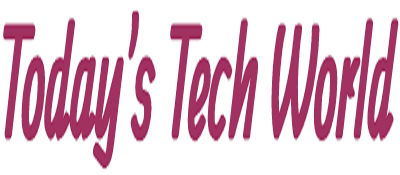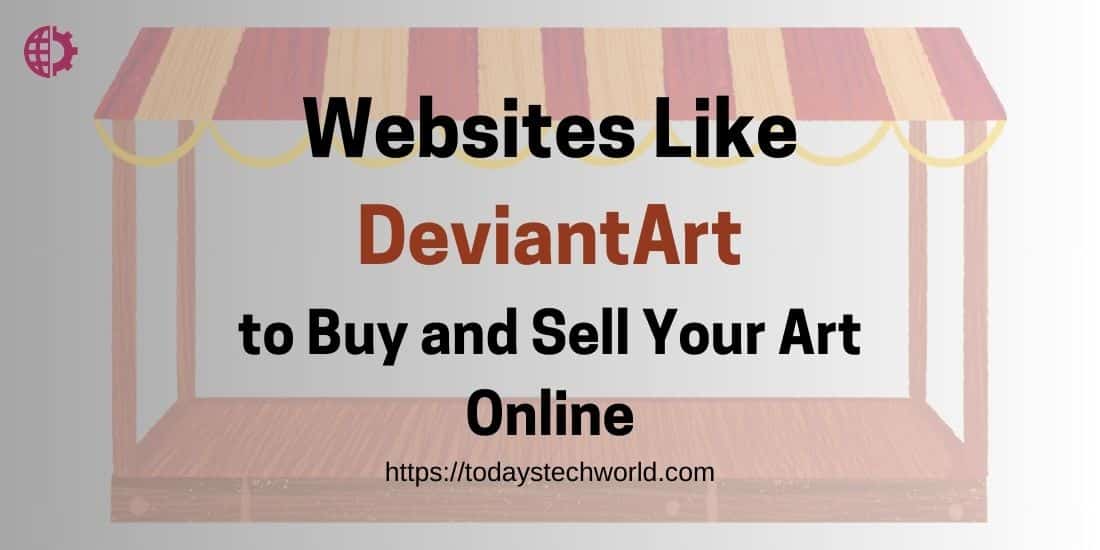Unlocking Artistic Frontiers: Exploring Platforms Beyond DeviantArt for Your Creative Showcase (Buy and Sell Art Online)
Here we are going to discuss top websites like DeviantArt to showcase your precious artwork. DeviantArt alternative websites discussed here are as useful as the original one but with tons of additional features.
DeviantArt has long been a cornerstone for creators worldwide in the dynamic world of online artistry. However, artists often seek alternative platforms to exhibit their work and engage with a broader audience, whether due to personal preferences, changing policies, or technical reasons. This article delves into a rich spectrum of platforms akin to DeviantArt, discussing their unique features, advantages, and drawbacks. From the professional-focused ArtStation to the collaborative Behance, we’ll explore diverse alternatives, offering artists valuable insights to enhance their online presence. Join us to uncover platforms that resonate with your artistic vision and aspirations.
Before going to discuss art sharing websites like DeviantArt let’s discuss the primary DeviantArt itself.
Contents
- 1 What is DeviantArt and why do you need to look for alternatives to DeviantArt?
- 2 Top websites like DeviantArt
- 3 Closing Thoughts
What is DeviantArt and why do you need to look for alternatives to DeviantArt?
DeviantArt has been a pioneer in the online art community, providing a platform for artists worldwide to showcase their creativity. DeviantArt rose to prominence for several notable reasons. It provided a platform for users to build their portfolios without any initial financial investment, making it accessible to a wide range of artists. The platform’s educational approach was highly commendable, fostering a learning-friendly environment.
Despite its initial appeal, DeviantArt experienced a decline in popularity over time. One drawback was its limited features, notably the absence of tools for designing websites, which attracted users to other platforms. Additionally, being a global community, DeviantArt faced challenges such as the posting of a significant amount of malicious content, including explicit nudity, gore, and intense violence.
Given these considerations, the need for websites like DeviantArt became apparent. Artists sought alternatives that addressed these drawbacks and provided a more suitable environment for showcasing their talents without compromising on essential features.
Top websites like DeviantArt
1. Our Art Corner
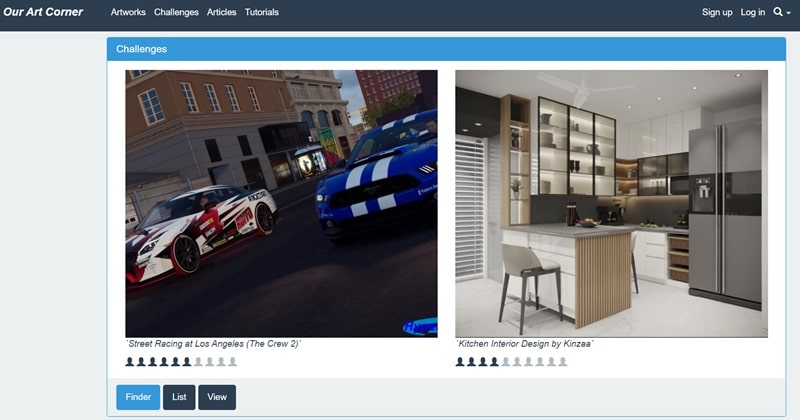
Our Art Corner emerges as a dynamic and challenging alternative to websites like DeviantArt, providing artists with a unique space for sharing their designs on a global scale. This platform is particularly known for its emphasis on critique and challenging activities, creating an engaging environment for artists seeking a replacement for DeviantArt.
One distinctive feature of Our Art Corner is its challenge section, setting it apart from other art-sharing platforms. This section provides artists with an opportunity to test their skills against competitors, fostering a spirit of healthy competition and growth within the community.
The rules for art challenges on Our Art Corner add a layer of interaction and gamification to the platform. From posting work to voting and engaging with comments, users can earn and spend credits, creating a dynamic and participatory experience. This unique credit system encourages artists to actively participate in challenges, voting, and fostering positive interactions within the community.
As with any platform, Our Art Corner has its set of pros and cons. The challenge section, while unique and engaging, may inadvertently shift the focus toward prizes rather than artistic expression. Artists should be mindful of maintaining a balance between the competitive aspect and the intrinsic joy of creating art.
For artists seeking alternatives to DeviantArt, Our Art Corner stands out as a platform that not only provides a global stage for sharing designs but also encourages active participation through its challenge section. Whether you’re honing your skills or engaging in friendly competition, Our Art Corner offers a distinctive and vibrant space within the diverse landscape of art-sharing websites.
Related Read: Websites to sell your code
2. ArtStation: Elevate Your Portfolio

ArtStation stands out for its focus on professional portfolios. It’s a preferred platform for concept artists, illustrators, and 3D artists. With a sleek interface, it emphasizes high-quality visuals and provides a space for artists to showcase their best work.
Pros
- ArtStation offers artists the chance to showcase and sell their work while also presenting avenues for securing new design projects.
- Engaging in diverse challenges, artists can qualify to contribute blog articles, gaining exposure and recognition within the creative community. Priority support ensures a seamless experience.
- The platform goes beyond mere presentation, allowing users to delve into analytics, enabling them to track and understand visitor behavior. ArtStation, known for its professional focus, provides a comprehensive suite of features tailored to elevate artists’ careers and expand their artistic horizons.
Cons
- May be less suitable for hobbyist artists.
- Accessing learning sessions, utilizing 4k images, and eligibility for contributing blog articles require opting for the Plus or Pro plan on ArtStation.
- While the platform offers extensive features, some users may find the cost of upgrading to the Plus or Pro plan relatively high.
3. Behance: Creativity Meets Collaboration
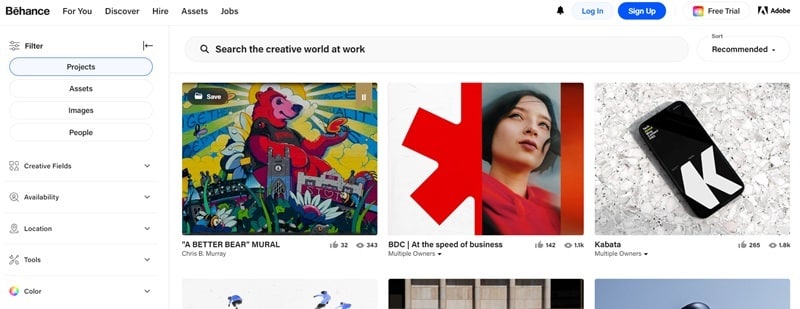
Exploring artistic horizons beyond traditional platforms like DeviantArt leads us to discover versatile alternatives such as Behance, an integral part of the Adobe Creative Cloud. Behance stands out as a dynamic platform that places a strong emphasis on collaboration and networking, providing artists with a multifaceted space to showcase their projects.
As one of the noteworthy websites like DeviantArt, Behance caters to artists of all backgrounds and disciplines. Its versatility makes it a suitable platform for a diverse range of art forms, allowing creators to express themselves freely. Whether you’re an illustrator, graphic designer, photographer, or any other type of visual artist, Behance offers a stage to exhibit your work and connect with a global creative community.
What sets Behance apart is its integrated approach to collaboration. Artists can not only display their portfolios but also engage with other creatives, fostering a sense of community and mutual inspiration. This collaborative aspect makes it a valuable resource for those seeking to expand their network and collaborate on innovative projects.
Pros
Moreover, Behance serves as a professional hub where artists can seek job opportunities and freelance work. This unique feature distinguishes it from traditional art-sharing platforms, making it a go-to destination for artists aiming to turn their passion into a profession.
Cons
However, like any platform, Behance has its set of pros and cons. While it’s collaborative features and professional networking opportunities are appealing, some users may find its broad focus less niche-specific compared to platforms like DeviantArt. Additionally, artists experiencing issues with DeviantArt, such as DeviantArt not working, may find Behance to be a reliable alternative to continue showcasing their art seamlessly.
In conclusion, Behance emerges as a compelling alternative to DeviantArt, offering artists a diverse and collaborative space to showcase their creativity, connect with like-minded individuals, and explore professional opportunities within the expansive realm of the Adobe Creative Cloud.
4. Pixiv: A Global Art Community

Hailing from Japan, Pixiv has garnered global acclaim as an animated and inclusive art community, positioning itself among notable websites like DeviantArt. This platform has become a focal point for artists delving into illustration and manga, offering a distinctive space for sharing their creative endeavors.
Pixiv’s emphasis on illustration and manga makes it a noteworthy alternative for artists seeking platforms similar to DeviantArt. With its global appeal, Pixiv facilitates a rich exchange of artistic expressions, connecting creators with a diverse and appreciative audience. You can even create a live sketching or drawing session to broadcast and connect with your audience.
As an alternative to DeviantArt, Pixiv addresses the needs of artists who may be seeking a specialized community for their illustration and manga-focused work. This unique positioning distinguishes Pixiv from broader art-sharing platforms, making it an ideal choice for those with a specific artistic niche.
In the context of users facing issues like DeviantArt not working, Pixiv emerges as a reliable alternative, offering a seamless experience for artists to showcase their creations. The platform’s international popularity ensures that artists can overcome technical challenges and continue engaging with their audience without interruptions.
Pixiv, with its vibrant and community-driven approach, contributes to the diverse landscape of art-sharing websites like DeviantArt. Artists exploring alternatives will find Pixiv to be a welcoming space where they can not only display their talent but also connect with like-minded individuals across the globe.
Pros:
The global community has an emphasis on illustration and manga making it a popular and user-accepted platform.
Cons:
Language barrier for some users. Also, it lags a couple of basic features like not being able to provide feedback, non-user-friendly navigations, etc.
5. ArtPal: Where Art and Commerce Meet

ArtPal stands out as a compelling choice among websites like DeviantArt, offering artists not just a platform to showcase their work but also a lucrative avenue for selling art. For those artists with aspirations to transform their passion into a business venture, ArtPal becomes an excellent option. The platform empowers artists to set their prices, providing them with the opportunity to earn a profit from their creative endeavors.
In the realm of art-sharing websites like DeviantArt, ArtPal’s unique feature of integrating art sales elevates it as a valuable resource for artists aiming to monetize their talents. Whether you’re a seasoned artist or an emerging talent, ArtPal caters to the entrepreneurial spirit within the art community, presenting a user-friendly interface where artists can seamlessly manage their portfolios and commercialize their creations. For those exploring alternatives due to reasons like DeviantArt not working, ArtPal emerges as a promising platform, bridging the gap between artistic expression and entrepreneurship.
6. Etsy
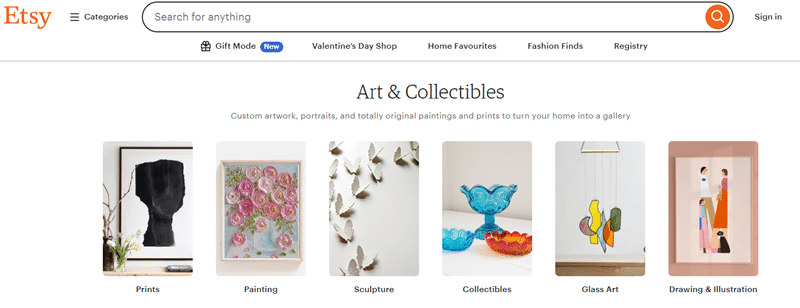
Etsy has emerged as a powerhouse within the realm of online marketing, experiencing rapid growth in recent years. Primarily known for its specialization in handmade items and vintage goods, Etsy has become a go-to platform for artists and small businesses alike, establishing its place among websites like DeviantArt.
One of the notable advantages of Etsy is its built-in analytics, providing sellers with valuable insights into their shop performance. Setting up an Etsy store is a straightforward process, making it accessible for artists and entrepreneurs looking to showcase and sell their unique creations. Listing products on Etsy serves as an effective strategy to boost sales, and the platform’s strong support for small businesses adds to its appeal.
Despite its strengths, Etsy does have some limitations. Sellers are restricted to selling handmade items only, which may not suit those with a broader range of products. Additionally, the Etsy market, due to its popularity, could be perceived as saturated, requiring sellers to adopt strategic approaches to stand out.
While Etsy provides an excellent platform for artisans and entrepreneurs, it’s worth noting that it may entail some additional financing. This investment, however, can be seen as a valuable step toward reaching a broader audience and tapping into Etsy’s extensive user base.
For artists exploring alternatives to DeviantArt, Etsy offers a unique avenue for selling handmade and vintage items, providing a combination of user-friendly features, built-in analytics, and support for small businesses. As with any platform, it’s essential for sellers to weigh the pros and cons to determine if Etsy aligns with their creative and business goals.
7. ConceptArtWorld

ConceptArtWorld stands as one of the most expansive and dynamic online communities dedicated to artworks. Serving as a blend of art forums and art classes, this platform caters primarily to digital art while also accommodating questions from various genres, making it a standout among websites like DeviantArt.
One of the standout advantages of ConceptArtWorld is the sheer volume of topics it covers, reflecting the engagement of its vast audience. This diversity creates a rich environment for artists to explore different aspects of their craft and connect with like-minded individuals. Additionally, the platform presents numerous job opportunities, including roles from renowned art studios. The allure of ConceptArtWorld is further enhanced by the potential for substantial payments, especially given the prevalence of remote work opportunities.
However, it’s crucial to acknowledge the drawbacks as well. While ConceptArtWorld offers a wide array of opportunities, income on the platform can be inconsistent. Artists may find that the irregular and hectic schedule, inherent in the nature of creative work, poses challenges in terms of financial predictability.
For artists seeking alternatives to DeviantArt, ConceptArtWorld emerges as a powerhouse, providing a robust community for artistic exploration, learning, and professional opportunities. With its expansive range of topics and job facilities, artists can navigate the complexities of the art world while acknowledging the potential challenges associated with income stability and scheduling.
8. Virink: What to draw

Virink: What to Draw is a rapidly growing mobile app tailored for users in regions like Russia and Eastern Europe, presenting itself as an innovative alternative to websites like DeviantArt. This unique platform distinguishes itself by offering users random drawing ideas, making it an ideal tool for artists seeking inspiration.
The app operates on a simple yet effective premise – when faced with creative block or uncertainty about what to draw, users can simply push a button to receive carefully curated drawing ideas across a diverse range of topics. Virink aims to be more than just an idea generator; it serves as a catalyst for developing imagination and expanding artistic horizons. The inclusion of art prompts aims to infuse paintings with creativity and uniqueness.
The functionality of the application is designed to cater to artists and creatives using various mediums, including graphic tablets, computers, or traditional paper and paints. Users can effortlessly view drawing tasks, add them to favorites for later use, and revisit any missed tasks.
Virink comes with several advantages, making it a favorable option for artists seeking alternatives to DeviantArt. Language translation poses no hindrance, ensuring accessibility for a wider audience. The app maintains a user-friendly interface with minimal advertisements, providing a seamless experience. Its usefulness extends to aiding artists during bouts of creative block, and its offline functionality allows for uninterrupted use even without an internet connection.
However, like any app, Virink has its drawbacks. Users may encounter pop-up ads, which can be an inconvenience during the creative process. Additionally, the drawing ideas may not resonate with everyone, as artistic preferences vary.
For artists in search of an alternative creative spark, Virink: What to Draw stands out as a unique and engaging mobile app, offering a convenient solution to overcome creative blocks and explore new artistic horizons.
Closing Thoughts
In conclusion, navigating the expansive realm of artistic expression entails exploring diverse platforms beyond the familiar terrain of DeviantArt. Websites like DeviantArt, ArtStation, Behance, Pixiv, ArtPal, Etsy, Our Art Corner, and Virink: What to Draw each brings their unique strengths to the table. Whether you seek professional exposure, collaborative opportunities, or a specialized community, these alternatives cater to various artistic aspirations.
Understanding the pros and cons of each platform empowers artists to strategically expand their online presence. Whether you prioritize the global reach of Behance, the commerce focus of ArtPal, or the community-driven ethos of ConceptArt.org, the alternatives presented here offer a myriad of possibilities.
As you embark on this journey beyond DeviantArt, consider the keywords – websites like DeviantArt, DeviantArt alternative websites, websites similar to DeviantArt, art sharing websites like DeviantArt, and DeviantArt not working. By strategically choosing the platform that aligns with your artistic vision and goals, you can elevate your online presence and connect with diverse audiences across the vast landscape of art-sharing websites. May your exploration be rewarding and your artistic endeavors find the perfect canvas to flourish.
